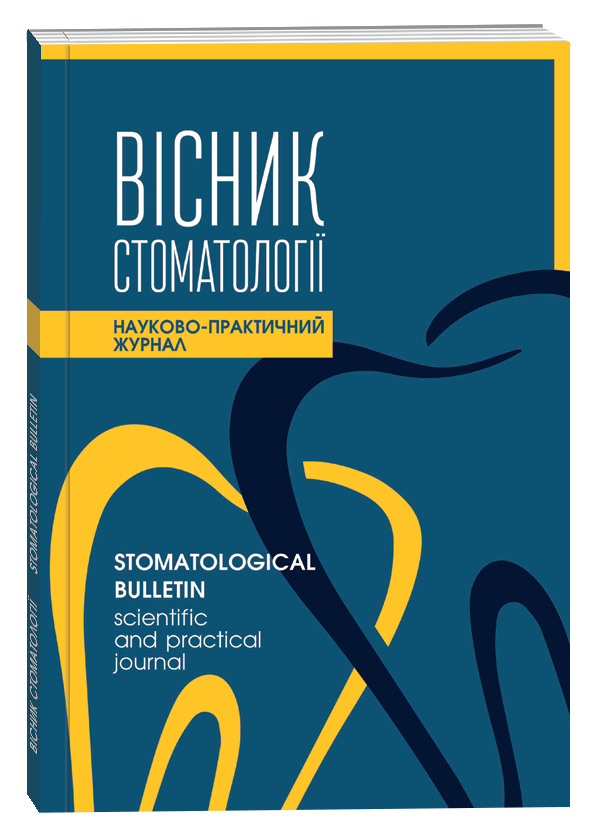THE MAIN RISK FACTORS FOR INFLAMMATORY PERIODONTAL DISEASE IN YOUNG PEOPLE
DOI:
https://doi.org/10.35220/2078-8916-2019-32-2-65-68Keywords:
hygiene of oral cavity, chronic catarrhal gingivitis, young age, risk factors of inflammation of gumAbstract
A high percentage of the prevalence of inflammatory periodon-tal disease at a young age causes urgency of treatment and pre-vention of inflammatory diseases of periodontal tissue at a young age. Therefore, the research purpose was to investigate the hygienic condition and identification of the main risk factors for gingivitis in patients 18-30 years. For the study observed all 286 people aged from 18 to 30 years. To assess the hygienic condition of the oral cavity and determine the thickness of plaque indices used OHI-S (simplified oral hygiene index Green Vermilyona) and Silness Loe. Studies of oral hygiene status sug-gests that patients with different etiologies of periodontal tissue inflammation oral hygienic condition ranged from "satisfactory" to "poor." Therefore the results of the study of hygiene and peri-odontal indices and samples confirmed the presence of objec-tively expressed mild inflammation in the gums in patients with chronic catarrhal gingivitis in young adults. Most often inflam-mation in the gums, namely, chronic catarrhal gingivitis was de-termined in patients with fixed prosthesis designs in the mouth or in violation of the bite, which are major risk factors for peri-odontal disease occurring in young adults from 18 to 30 years.
References
Albandar, J.M. Periodontal diseases in North America / J.M. Albandar // Periodontol-2000. – 2002. – Vol. 29. – P.31–69.
Улитовский С.Б. Циркулярная зависимость развития за-болеваний па-родонта / С.Б. Улитовский // Новое в стоматологии. – 2000. – № 4. – С.55–64.
Albandar, J.M. Global risk factors and risk indicators for periodontal diseases / J.M. Albandar // Periodontol-2000. – 2002. – Vol. 29. – P. 177– 206.
Neely A.L. The natural history of periodontol disease in man. Risk factors for progression of attachment loss in individuals receiving no oral health care / A.L. Neely, T.R. Holford, H. Loe // J. periodontal. – 2001 – Vol. 72, № 28. –P. 1006–1015.
Буланников A. C. Заболевания пародонта. Клиника, ди-агностика и ле-чение / A.C. Буланникова // Медицинская помощь. – 2005. – 4. – С.21–24.
Курякина Н.В. Заболевания пародонта / Н.В. Курякина. –М.: Мед книга, 2005. –43 с. 7. Григорьян А. С. Микроорганизмы в заболеваниях паро-донта: экология, патогенез, диагностика / Григорьян А. С. – Моск-ва: ГЭОТАР-Медиа, 2007. – 56 с.
Канканян А.П. Болезни пародонта: новые подходы в этиологии, патогенезе, профилактике и лечении / Канканян А.П., Леонтьев В.К. – Ер.: Тигран Мец., 2000. – 360 с.
Сааг М.Х. Состояние пародонта в молодом возрасте: ав-тореф. дис. на соискание учен. степени канд. мед. наук: спец. 14.01.22 «Стоматология» / М.Х. Сааг – JL, 1999. – 18 с.
Ainamo J. New perspectives in epidemioligie and prevention of periodontal diseases / J. Ainamo // Dtsch. Lahnarztl. – 2000. – Vol. 43. – №6. – P. 623-630.
Мониторинг и оценка оздоровления полости рта: Докл. Комитета экспертов ВОЗ. –Женева: ВОЗ, 1991. – 73 с.
Periodontal disease prevalence in different age groups in
Japan as assessed according to the CPITN / H. Miyazaki, N. Hanada, M. I. Andoh [et al.] // Commun. Dent. Oral. Epidemiol. – 2000. –Vol. 17. –P. 71-74.









